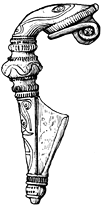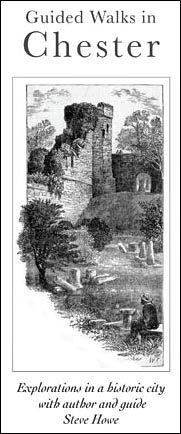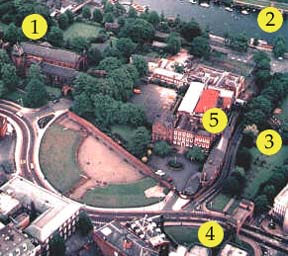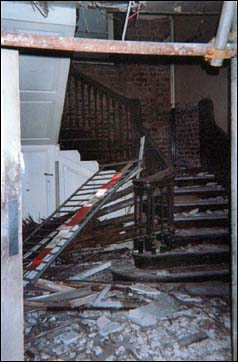"We regret that no progress has been made in uncovering
the amphitheatre site. The inactivity and indecision in the matter is deplored,
and although several communications have been adressed to the City Council
on the subject, we appear to be no nearer a solution. Instead of the site
being an attraction to the city, bringing visitors and so increasing trade,
it is becoming a rubbish heap and a disgrace."
Extract
from the Annual Report of the Chester Chamber of Trade, 1933
 etween
July and September 2000, while the Chancellor's courthouse and car park
continued to rise over part of the amphitheatre, the previously-excavated
half was subjected to a small-scale 'community-based' excavation, run by the
city council's Chester Archaeology with the assistance of the Chester Archaeological
Society, students from Chester College and other volunteers. The
reason
for
the
exercise
was
explained
by
its
leader, Keith
Matthews: etween
July and September 2000, while the Chancellor's courthouse and car park
continued to rise over part of the amphitheatre, the previously-excavated
half was subjected to a small-scale 'community-based' excavation, run by the
city council's Chester Archaeology with the assistance of the Chester Archaeological
Society, students from Chester College and other volunteers. The
reason
for
the
exercise
was
explained
by
its
leader, Keith
Matthews:
"Following extensive excavations in the 1960s and full publication in
1976, one might be forgiven for thinking that we know all there is to know
about the amphitheatre in Chester. But are any of the published 'facts' correct?
Do we need to excavate the unexcavated 60% of the monument to find out? Many
of the research questions relating to the Roman period that can be considered
of 'national' or 'international'  significance are capable of being addressed
without fieldwork, through archive reassessment or other desk-based research.
At this level, much of the fieldwork that might help answer various questions
would best be targeted, small-scale work." significance are capable of being addressed
without fieldwork, through archive reassessment or other desk-based research.
At this level, much of the fieldwork that might help answer various questions
would best be targeted, small-scale work."
Right: a bronze 'trumpet brooch' c. AD100, with silver inlay featuring a stylised animal head, excavated from the seating bank of the amphitheatre in 1961
"The rationale behind the project was to see how much (if any) archaeology
had survived the extensive excavations of the 1960s. Our understanding was
that the post-Roman deposits had been bulldozed to one side of the site and
then spread over the area that became the seating bank when the Ministry of
Works landscaped the site in the early 1970s. We expected that little would
survive under the modern gravel of the arena floor and that, at best, traces
of the timber amphitheatre might survive under the seating bank. We were also
concerned that stone we could see eroding through the gravel in the north
entrance might be in situ archaeology. We therefore located our trenches
to test these ideas."
It
was
also
being
claimed
in
some
circles
that
the
dig
was
a
hurredly
put
together
PR
exercise
designed
to
show
that
a
much-criticised
city
council
could
at
last
be
seen
to
be getting its finger out and
'doing
something'.
Mr
Matthews
was
at
pains
to
deny
this,
saying
they'd
been
working
towards
the
excavation
since
1995
and
the
work
was "unrelated
to"
the
council
decision
of
just
a
couple
of
weeks
earlier
to
work
towards
full
excavation
and
to
demolish
Dee
House.
That
English
Heritage's
granting
of
permission
for
the
dig
and
the
council
decision
came
at
the
same
time
was
merely
"coincidental"-
although
he
believed
that
the
work would help
with
the
preparation
of
a
full
excavation
strategy.
He
also
emphasised
the
difficulty
of
doing
anything
with
Scheduled
Monument
Consent,
saying
that
it
takes "a
cast
iron
Project
Design,
informal
chats,
formal
letters,
a
correctly
filled-out
application
form
and
then
a
minimum
of
six
weeks
'consideration'
by
English
Heritage".
Finds
on
the
site
included
the
expected
shards
of
Roman
and
later
pottery
and
also
a
bronze
hairpin
dating
from
around
100AD,
a
period
when
the
stone-built
amphitheatre
was
brand
new,
and
would
seem
to
indicate
that
it
wasn't
used
only
as
a
military
training
ground;
the
4
inch-long
pin
would
once
have
held
in
place
a
wealthy
Roman
lady's
elaborate
hairstyle,
so
affluent
women
were
evidently
visiting
the
amphitheatre
at
this
time,
and
presumably
not
merely
to
watch
squaddies
drilling...
 In
addition
to
the
above,
something
much
rarer
was
unearthed
by
a
volunteer
working
at
the
site-
a
flint
blade
dating
from
around
12,000
BC.
It
would
have
belonged
to
one
of
the
first
colonists
of
Britain
after
the
Ice
Age,
from
the
Upper
Paleolithic
period.
Although
finds
of
a
like
antiquity
have
previously
been
made
around Abbey
Green,
this
was
the
first
prehistoric
artefact
found
in
the
area
of
the
amphitheatre.
A
few
days
later,
another
volunteer
discovered an
arrow
or
spear
point
dating
from
around
4500BC-
a
period
before
widespread
farming
when
hunters
roamed
the
land
in
search
of
game
such
as
deer
and
wild
boar. In
addition
to
the
above,
something
much
rarer
was
unearthed
by
a
volunteer
working
at
the
site-
a
flint
blade
dating
from
around
12,000
BC.
It
would
have
belonged
to
one
of
the
first
colonists
of
Britain
after
the
Ice
Age,
from
the
Upper
Paleolithic
period.
Although
finds
of
a
like
antiquity
have
previously
been
made
around Abbey
Green,
this
was
the
first
prehistoric
artefact
found
in
the
area
of
the
amphitheatre.
A
few
days
later,
another
volunteer
discovered an
arrow
or
spear
point
dating
from
around
4500BC-
a
period
before
widespread
farming
when
hunters
roamed
the
land
in
search
of
game
such
as
deer
and
wild
boar.
In
the
arena,
much
evidence
came
to
light
of
the
damage
done
to
the
site
during
previous
excavations
and
the
consolidation
of
the
remains
for
public
display
by
the
Ministry
of
Works
during
the
1960s
and
70s.
Indeed,
it
looked
as
if
part
of
the
exposed
sandstone
bedrock
had
actually
been
'shaved
off'
to
make
a
level
surface
onto
which
they
laid
their
'protective'
layer
of
gravel.
The
'restorers'
had
showed
even
less
respect
for
the
Roman
drains:
the
peripheral
drain
had
been
completely
replaced
by
a
concrete
feature,
while
the
axial
drain
had
fared
similarly
badly.
Worse
still,
a
herringbone
pattern
of
concrete
land
drains
had
been
installed,
designed
(unsuccessfully)
to
improve
the
poor
drainage
of
the
arena.
Incidentally,
when
the
printed
report
upon
the
dig
was
published
in
the
Spring
of
2001,
it
made
the
puzzling
claim
that "the
local
press
had
given
the
impression
that
it
was
the exposed part
of
the
monument
that
was
due
to
be
built
on"
(we
are
in
possession
of
a
virtually
complete
set
of
cuttings
dealing
with
this
issue,
but
ne'er
a
mention
of
this
can
we
find)-
and
"at
least
one
tour
bus
announced
that
the
archaeological
trenches
were
part
of
the
foundations
of
a
new
superstore".
 Hmm.
Having
overheard
stranger
yarns
than
this
emanating
from
certain local tour guides,
we'll
admit
that
this
is
quite
possible... Hmm.
Having
overheard
stranger
yarns
than
this
emanating
from
certain local tour guides,
we'll
admit
that
this
is
quite
possible...
Keith
Matthews
and
his
team
undertook
a
further
series
of
excavations
in
2001.They
came
up
with
some
spectacular
findings,
which
you
can
read
about here.
Around
the
same
time,
Autumn
2000,
the Chester
Amphitheatre
Trust was
asked
by
the
city
council
to
set
out
its
detailed
initiative
for
the
excavation
of
the
monument
and
to
come
up
with
ideas
for
how
it
could
be
funded.
The
council
stressed,
however,
that "plans
from
other
interested
parties
would
also
be
welcome".
Conservative
Group
Leader,
Councillor Brian
Bailey commented, "The
resolution
of
the
council
makes
it
very
clear
that
responsibility
for
the
amphitheatre
now
rests
with
the
council (now
rests? Whose
was
it
before?)-
which
has
asked
its
officers
to
prepare,
in
partnership
with
other
interested
bodies,
detailed
and
costed
proposals.
It
means...that officers will
bring
forth
the
proposals..."
However,
we
gathered
that
Cllr Graham
Proctor had
requested
that
the
Trust
submit their own plans,
something
they
were
apparently
reluctant,
in
the
current
climate,
to
do,
saying
that "to
produce
a
plan
of
quality
and
depth
requires
the
input
of
the
city
council
itself
and
other
knowledgable
individuals
and
organisations.
We
could
spend
a
lot
of
time
and
money
putting
together
something
that
might
be
unacceptable
for
some
reason".
And
which
may
doubtless
have
proved
to
be
of
great
benefit
to
one
of
those
other
'interested
parties'...
Trust
founder Dr Liane
Smith reacted
to
Cllr
Bailey's
suggestions
by
emphasising
that "the
input
of
the
knowledge
of
the
officers"
would
be
needed
but
the
excavation
plans
themselves
would
need
to
be
drawn
up
by
a
"recognised
local
Roman
expert
with
due
consideration
given
to
post-Roman
remains".
The
Trust
announced
in
early September
2000 that
a
major
fund
raising
drive
was
to
commence
in
the
near
future-
with
an
initial
target
of
around £600,000.
Company
sponsorship
was
hoped
to
provide
a
high
proportion
of
the
money
needed,
paying
for
the
demolition
of
Dee
House,
the
clearance
of
the
site
and
two
years
of
excavation.
"Companies
would
give
donations
if
they
know
that
there
will
be
clear
recognition
of
their
contribution
in
terms
of
company
logos
at
the
visitor
centre".
After
that,
it
was
hoped
that
a
visitor
centre
would
bring
in
revenue
of
up
to £750,000
per
year,
paying
for
future
excavation
as
part
of
a
10-year
scheme.
Dr.
Smith
drew
up
an
initial
'plan
of
action'
entitled Steps
to
Success to
formerly
define
the
Trust's
aims.
It
outlined
three
key
elements:
•
The
production
of
an
excavation
plan
that
would
be
of
a
standard
to
convince
English
Heritage
to
allow
it.
"We
would
want
to
convince
them
that
this
is
an
excellent
project
which
they
could
support".
•
The
provision
of
a
self-funding
visitor
centre
"to
display
the
findings
and
present
the
site
imaginatively
to
people".
• Fundraising
issues;
the
initial
cost
of
implementing Steps
to
Success would
be £25,000,
including
£15,000
to
York-based
heritage
experts Past
Forward to
advise
on
a
business
plan
for
the
visitor
centre.
Steps
to
Success is
currently
being
studied
by
City
council
Head
of
Culture, Paul
Gover and
by
the
council's
four
group
leaders.
 Here
is
a revealing
aerial
view
of
the
Chester
amphitheatre and
its
surroundings
taken
a
few
years
ago. Compare
it
with
the
dramatic
1940s
'artist's
impression' of what could have been here,
with these early
maps- and also this aerial photograph of the area in late 2001 showing the new court house in situ. Aside from the dramatic semi-circle of the excavated portion of the
monument, also visible in the picture are... Here
is
a revealing
aerial
view
of
the
Chester
amphitheatre and
its
surroundings
taken
a
few
years
ago. Compare
it
with
the
dramatic
1940s
'artist's
impression' of what could have been here,
with these early
maps- and also this aerial photograph of the area in late 2001 showing the new court house in situ. Aside from the dramatic semi-circle of the excavated portion of the
monument, also visible in the picture are...
1. The
Church
of
St. John
the
Baptist.
Claims
from
some
quarters
that
a
fully-exposed
amphitheatre
would
result
in
the
destruction
of
the
remains
of
this
unique
and
ancient
church's
West
Tower
(just visible, surrounded
by
trees in the picture)
may
clearly
be
seen
to
be
quite
untrue. Cullinan's proposals, circa 1998, for a semi-circular hotel 'wrapping around' a completely excavated amphitheatre also demanded the destruction of this tower.
2. The
River
Dee. The
skyline
of
the
city
as viewed from
the
Handbridge side of the river is
now
dominated
by
the
newly-erected
courhouse,
as
may
be
seen here.
3. The
'Roman
Garden'. This pleasant park housing a collection of old stones rescued from development sites around the city underwent a splendid restoration around the same time that the 'real thing' next door was being built upon.
4. The
Newgate and
City
Walls. This was the south-east corner of the Roman fortress. Enlarged by the Saxons a thousand years ago, the city walls now extend down to the River Dee.
5. Dee
House. The
now-cleared
red-roofed
structures- extensions
to the old telephone exchange- behind
Dee House
were
on
the
site
of
the
new
County
Courthouse
and
the
open area
to
their
left
is
now
the
court's
car
park.
Although
quiet
when
this
photograph
was
taken,
the
line
of
Pepper
Street
/
Little
St. John
Street
/
Vicar's
Lane
running
around
the
edge
of
the
amphitheatre
is
normally
one
of
the
most
congested
sections
of
Chester's
Inner
Ring
Road
and
access
from
it
to
the
court
site
is
extremely
restricted.
Our city is blessed with the unique combination
of
the
fine
open
spaces
of Grosvenor
Park (just
out
of
shot,
beyond
the
church
on
the
left),
the
Roman
Garden,
the
beautiful Groves & River
Dee-
and
the
magnificent amphitheatre
itself. To many it would appear
sheer lunacy
to knowingly
condone
the
erection
of
a large
commercial
building
and
promote
even
more
traffic
in
this
extremely sensitive area...
|
 In
late
September
2000,
the
first
meeting
of
a
City
Council
panel
set
up
to
resolve
the
future
of
the
amphitheatre
and
Dee
House
agreed
that
a
conservation
plan
should
be
set
up
for
the
entire
area
and
committed
the
sum
of £15,000
towards
it,
a
similar
sum
to
be
sought
from
English
Heritage. In
late
September
2000,
the
first
meeting
of
a
City
Council
panel
set
up
to
resolve
the
future
of
the
amphitheatre
and
Dee
House
agreed
that
a
conservation
plan
should
be
set
up
for
the
entire
area
and
committed
the
sum
of £15,000
towards
it,
a
similar
sum
to
be
sought
from
English
Heritage.
All
four
Town
Hall
political
groups
were
said
to
be
backing
moves "to
progress
the
redevelopment
and
future
management
of
the
amphitheatre
and
its
surroundings"-
although
individuals
within
those
groups
remained
deeply
divided
on
key
issues
such
as
the
retention
or
demolition
of
Dee
House.
The
Chairman
of
the
panel,
for
example,
council
leader John
Price,
as
we
have
learned,
is now much
in
favour
of
the
former
option.
The
meeting
was
doubless
astonished
to
hear
Amphitheatre
Trust
co-founder Alan
Williams announce
that
the
Trust
envisaged
that
a "timescale
of
50
to
100
years" was
likely
to
be
necessary
for
the
completion
of
the
project-
indeed,
fellow
members
of
the
Trust
were
apparently
equally
astonished
at
Mr
Williams'
unilateral
declaration,
as
was
Conservative
leader, Brian
Bailey,
who
responded, "50
to
100
years
is
a
very
long
time.
We
need
to
be
doing
something
very
much
more
quickly
than
that-
as
soon
as
we
have
a
conservation
plan.
I
hoped
we
would
be
thinking
about
a
very
much
shorter
timescale". Cllr
Haynes
agreed,
saying,
"It
must
be
something
less
than
50-100
years".
Left: the destroyed interior of Dee House
The
news
must
have
been
music
to
the
ears
of
those
within
some
areas
of
the
planning
machine
however.
In
their
eyes,
it
would
allow
the
court
house
to
remain
in
use
for
the
rest
of
the
century,
make
the
commercial
redevelopment
of
Dee
House
much
more
viable
and,
of
course,
allow
many
of
the
difficult
decisions
to
be
'put
off'
to
eventually
become
the
problem
of
some
future
generation.
What
was
in
Mr
Williams'
mind
to
compel
him
to
make
such
a
statement
is
a
mystery-
and
a
source
of
great
concern
to
many.
Perhaps
it
was
just
a
slip
of
the
tongue.
A
fellow
Trust
member
told
us
they
feared
his
remarks "were
likely
to
cost
us
a
great
deal
of
the
support
we've
built
up
among
the
public".
And
we
agreed
with
them.
And
what
of
Dee
House,
now
the
resolution
had
been
passed "against
the
advice
of
officers" to
go
ahead
and
demolish
it?
The
council
is
legally
responsible
for
maintaining
the
listed
building
in
a
'weatherproof
condition'
until
such
time
as
a
final
decision
is
taken
regarding
its
future.
The
repair
of
the
as-yet
unexplained
fire
damage
to
the
roof
has
been
completed,
presumably
having
been
paid
for
from
insurance,
but
we
were
told
that
a
sum
of
around £210,000
was
apparently
needed
straight
away
to
make
good
the
results
of
long
term
neglect.
Some
asked,
if
the
roof
had
been
fixed,
what
else
was
involved
in
this
figure
produced
by
the
council
officers?
There
were
few
new
costs
as
far
as
they
could
see.
But
in
addition,
a
survey
of
the
building's
architectural
features-
what's
left
of
them-
is
apparently
necessary
before
demolition
consent
can
be
given-
at
the
remarkable
cost
of
around £20,000...
Then
there
would
be
the
annual
maintainance
costs
to
keep
Dee
House
in
good
order
until
it
is
either
done
up
or
knocked
down.
On
top
of
this, a
brief
for
the
eventual
excavation
and
presentation
of
the
amphitheatre
has
to
be
drawn
up
for
consultation-
at
a
cost
yet
to
be
ascertained. Remembering
the
vast
quantities
of
glossy,
one-sided
documents
floating
around
during
the CDTS
Busway so-called
'consultation'
exercise,
we
predict
it'll
be
a
high
one.
 Unfortunately
for
the
council,
and
to
the
amazement
of
interested
citizens,
it
transpired
that
they
had
actually
made no
provision
at
all for
the
above
not-inconsiderable
expenses!
City
Councillor Doug
Haynes remarked
after
a
meeting
in
July
when
these
matters
came
to
light, "This
is
the
first
time
I
have
left
a
council
meeting
feeling
embarrased
and
ashamed.
None
of
these
costs
is
in
the
budget.
We
already
have
an
estimate
of
almost
£250,000.
I
don't
wish
to
see
anything
cut
from
other
services". Unfortunately
for
the
council,
and
to
the
amazement
of
interested
citizens,
it
transpired
that
they
had
actually
made no
provision
at
all for
the
above
not-inconsiderable
expenses!
City
Councillor Doug
Haynes remarked
after
a
meeting
in
July
when
these
matters
came
to
light, "This
is
the
first
time
I
have
left
a
council
meeting
feeling
embarrased
and
ashamed.
None
of
these
costs
is
in
the
budget.
We
already
have
an
estimate
of
almost
£250,000.
I
don't
wish
to
see
anything
cut
from
other
services".
Right:
A
view
from
1958
of
the
gardens
which
formerly
covered
part
of
the
amphitheatre
site.
Behind
may
be
seen
the
Grosvenor
St. John's
School,
now
the
Chester
Visitor
Centre,
and
the
remains
of St. John's
House,
then
being
demolished
by
the
Chester
Archaeological
Society
to
commence
the
excavation
of
the
amphitheatre.
The
gardens,
further
views
of
which
may
be
seen here and here,
were
to
follow
soon
after.
Cllr David
Evans won
the
Understatement
of
the
Year
Award
when
he
described
the
financial
implications
as
"interesting".
He
admitted,
"We
have
always
known
we
had
an
obligation
to
keep
Dee
House
in
order,
yet
it
appears
we
have
nothing
in
the
budget
to
do
this.
It
would
be
worthy
of Alice
in
Wonderland if,
having
decided
to
demolish
Dee
House,
we
should
be
faced
with
a
bill
to
put
it
in
good
order".
'Interesting'
was
not
the
adjective
we
would
have
chosen.
To
declare
that
there
was
"nothing
in
the
budget"
for
schools,
libraries
or
highway
maintainance
would
have
produced
a
justifiably
angry
response
from
the
citizens.
So
what
was
the
difference
regarding
Dee
House?
Emptying
the
bins
or
protecting
listed
buildings-
both
are legal
obligations upon
local
authorities.
Where
was
the
necessary
money
to
come
from?
And
what
could
have
accounted
for
such
an
act
of
omission?
We
assumed
that
the
original
idea
was
for
Dee
House
and
its
associated
expenses
to
have
been
off
the
council's
hands
by
now,
delivered
safely
into
the
tender
care
of
David
McLean
Ltd,
and
being
turned
into
lovely
offices...
In
October
2000,
the
scandal
of
the
Chester
Amphitheatre
was
discussed
at
the
Tory
Party
Conference!
City
councillor Eveleigh
Moore
Dutton adressed
a
3000-strong
audience
on
the
final
day
of
the
conference
in
Bournemouth,
describing
the
courthouse
project
as
"outrageous
and
contrary
to
the
will
of
the
people
of
Chester
and
common
sense"
and
mocked
the
Lord
Chancellor
by
referring
to
him
as
"Lord
Invine
of
Lairg
and
Wallpaper" (a satirical reference to his having shortly before spent £650,000 of public money upon the redecoration of his Westminster residence).
Summing
up,
Cllr
Moore
Dutton
said
"Thus
our
heritage
is
being
locked
away
beneath
a
courthouse
and
associated
car
park.
The
amphitheatre
is
part
of
our
national
heritage
and
I
therefore
appeal
for
your
help
and
support".
Go
on
to Part
VII, read a growing
collection
of letters to
us
and
the
local
press
about
the
amphitheatre- or visit the ancient Church of St. John the Baptist instead... |